Understanding Darknet Risk to Individuals and Corporations
Risk is a word regularly used across information security circles and CISO agendas. And, in light of the recent surge of indiscriminate organizational ransomware attacks, companies are aggressively attempting to identify and mitigate any cybersecurity risk that could lead to potentially extensive financial and reputation damage, especially from a high profile cybersecurity attack or data breach. Meanwhile, individual persons also struggle to know how concerned they should be in mitigating their own personal risk to when, not if, their sensitive personal information appears on the deep web and darknet.
In this blog, DarkOwl analysts dig into the domain of risk, taking a closer look at the threats corporations and individuals face, how risk is calculated and mitigated. Underground digital communities within hidden and anonymous networks are an integral role in identifying the threats at play, and DarkOwl works alongside its partners to help provide the critical monitoring of potential markers of risk using its darknet search platform.
What is risk and what is the darknet’s role in risk calculations?
Risk is traditionally thought as a multiplier of likelihood and severity, or consequence of outcome; however, in cybersecurity the definition is expanded for consideration of intention or threat. For example, in a personal risk scenario, one’s leaked credentials (e.g. usernames, e-mail addresses and passwords) might appear in commercial data breach leaks which poses one degree of risk, but the minute those same credentials appear in conjunction with direct malicious intent to cause financial or direct harm, then their personal risk increases dramatically; DarkOwl has observed similar specific targeting frequently in the darknet. The same would be true for the intention of an attack against a corporation or government organization, but this is understandably much harder to quantify.
The U.S. Department of Homeland Security (DHS) defines risk as the “potential for an unwanted outcome resulting from an incident, event, or occurrence, as determined by its likelihood and the associated consequences” such that: likelihood is defined as “the chance of something happening, whether defined, measured or estimated objectively or subjectively, or in terms of general descriptors (such as rare, unlikely, likely, almost certain), frequencies, or probabilities” and consequence is given as “the effect of an event, incident, or occurrence, including human consequence, economic consequence, mission consequence, psychological consequence.”
The DHS risk assessment model is more simplify defined as a function of three variables: threat, vulnerability, and consequences with full recognition “these values are not equal” as stated by DHS Secretary Chertoff in 2005. “For example, some infrastructure is quite vulnerable, but the consequences of an attack are relatively small; other infrastructure may be much less vulnerable, but the consequences of a successful attack are very high, even catastrophic.”
In organizational risk calculations, threat includes anything that can cause harm to the organization and that could expand to include threats from natural disaster (wildfire, hurricanes, and earthquakes) or even a significant hardware / backup failure that triggers a disruption in services or production and not necessarily exclusive to cybersecurity attacks by external malicious entities.

There are numerous interpretations, philosophies, and variations on this formula and luckily organizations are given extreme flexibility in conducting internal risk assessments by applying risk models of varying degrees of detail and complexity of threat identification and vulnerabilities – of which cybersecurity has become increasingly critical.
Threat calculations are often tied to scenarios with likelihoods of occurrence that involve an adversary’s intent, capability, and targeting. When we look at the darknet’s role in risk and threat vectors, especially when considering the risk to a company’s brand or stakeholders, malicious threat actors who conduct operations in the underground (e.g. cybercriminal organizations, nation state actors and proxies, and cyber opportunists) proactively hunt for and attempt to exploit sensitive data for personal financial gain by whatever means possible, often manipulating unpatched vulnerabilities and crafting new exploits in the wild.
DarkOwl analysts also regularly witness critical corporate and personal information actively shared across various underground digital communities in the darknet and deep web and have categorized the types of vulnerable data at risk accordingly, delineating corporate and individual personal risk, with careful consideration that these two are intricately interrelated due to the fact humans are one of many risks corporate organizations must consider when calculating their cybersecurity risk. The region where corporate and individual risk overlap is of most critical consideration as well as the extent and volume of readily available information for threat actors to launch their attacks.
Likewise, the more accumulated data a threat actor has access to for an individual or a corporation increases the risk accordingly.
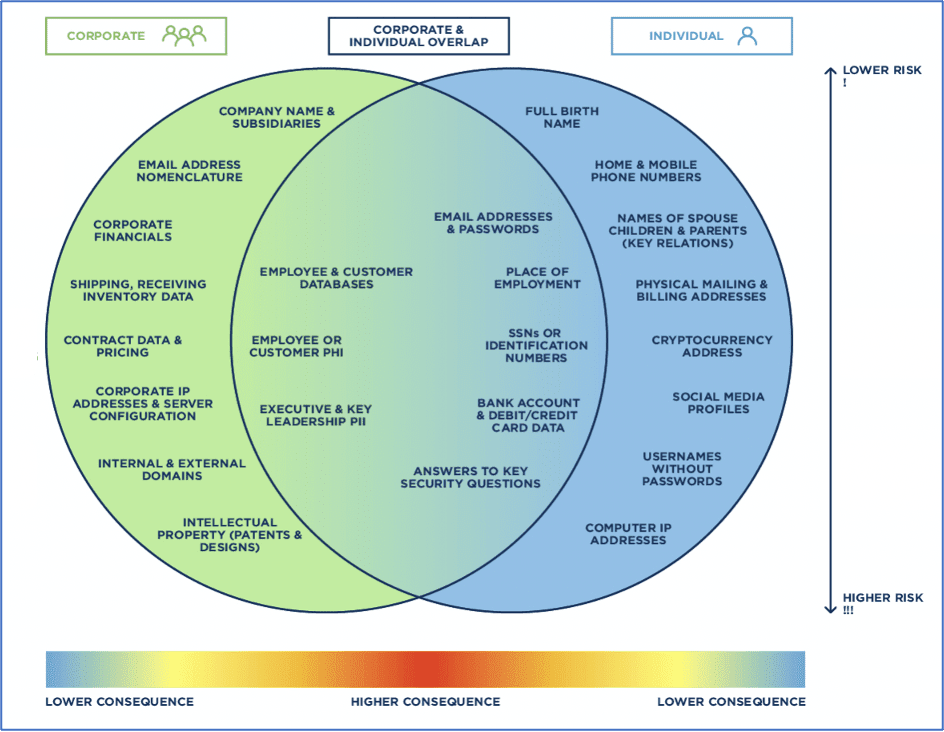
Figure 1: Visualizing the threat to corporations and individuals
Corporate Risk and The Darknet
The possibility of a cybersecurity attack against a corporation feeds a number of different corporate risk calculations: the loss of customer data presents a significant risk to a company’s brand, reputation and stakeholders; there’s moderate risk for loss of sales due to counterfeit goods offered on the darknet and direct reputational attacks on discussion forums and social media; there is direct risk via the executives and key leadership of an organization for business e-mail compromise (BEC) phishing attacks or financial extortion through physical threat to executive’s family; and, there is risk to attack via third (and fourth) party vendors and suppliers.
The consequences of an attack against a corporation can include:
-
Unauthorized access to a corporate network
-
Misuse of information by an authorized user
-
Loss of access to corporate data (via deletion or encryption)
-
Disruption of service or productivity
-
Reputational loss and damage to brand or corporate image
The risk of unintentional data compromise
As nearly every security researcher and infosec professional would agree, the volume of organizational data leaks via unauthorized network intrusion attacks over the last twelve to eighteen months is troubling. Identity Force identified over 74 organizations across every industry segment that suffered network intrusion attacks in 2020 resulting in public reporting of sensitive PII leaked for malicious use on the deep web and darknet. From April through December 2020, DarkOwl observed 144 victim companies and non-profit organizations mentioned by the REvil ransomware criminal gang on their darknet data leak onion service, Happy Blog, such that the “real” volume of compromised corporate information and customer authentication data in circulation from 2020 is likely significantly higher.
While large commercial data leaks receive press coverage, with phrases like “millions of records of user data exposed” there is an unknown number of organizations that have likely secretly dealt with a critical cybersecurity incident without ever disclosing the breach to their customers or users due to the consequences of reduced consumer confidence.
Extortion as a service is an increasingly successful sector of the underground criminal ecosystem and involves stealing sensitive personal or corporate information and then leveraging unauthorized access to this information to force the victim to pay, essentially blackmailing the victim, in exchange for quasi protection of their data. Threat actors utilize hacking forums and discussion boards across the deep web and darknet to explore potential vulnerabilities, sometimes expressing interest in specific industries, companies, and individuals, then finally sharing or selling the sensitive information they have stolen – resulting in significant reputational and/or financial loss for the victim organization.
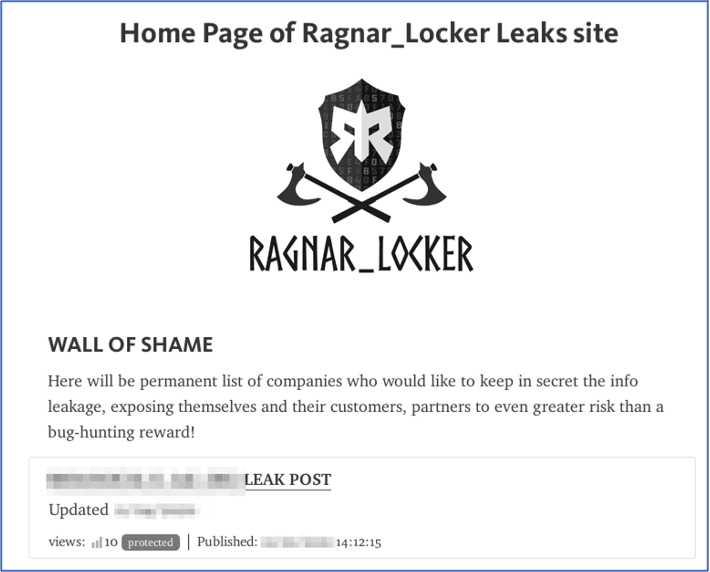
Figure 2: Example ransomware leak site on the darknet for Ragnar Locker Group
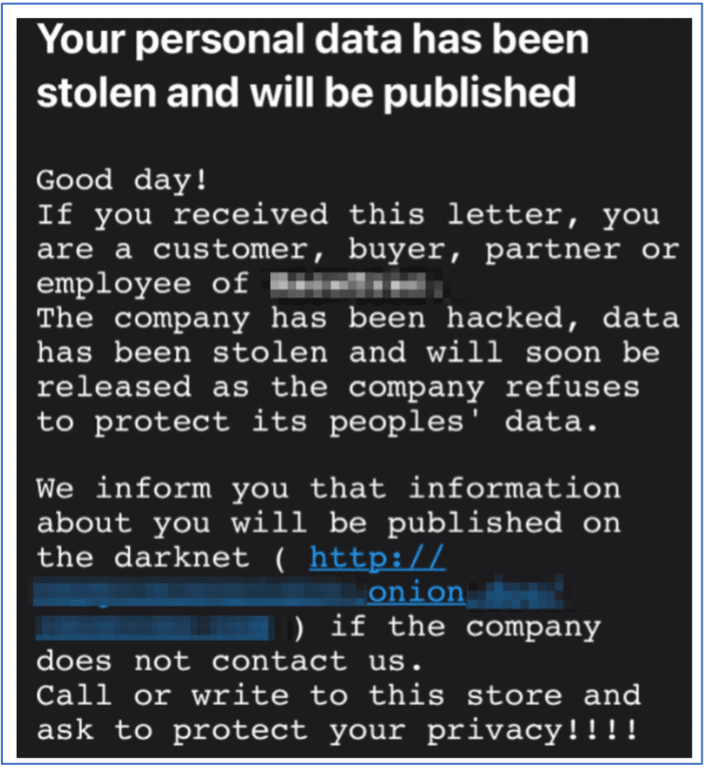
Figure 3: Example e-mail sent to victim’s customers by a ransomware group (courtesy krebsonsecurity.com)
Lately, darknet onion services that are hosted by cybercriminal gangs have been a key repository for the stolen and extorted data collected from victim networks via ransomware attacks.
DarkOwl has documented over two dozen unique ransomware-specific onion services for public release of information about their victims if the demanded ransom is not paid. Some ransomware groups even mock their victims using terms like “Wall of Shame” to taunt companies who attempt to avoid public disclosure of their compromise and sensitive data leak. Brian Krebs reported that the REvil ransomware gang started e-mailing customers of its victims to increase the pressure on the victim organization to pay the demanded ransom.
Notably, a reader of Kreb’s report commented on the optics around the fact they had received the notification e-mail from the criminals three months after the victim’s third-party let their customers know about the attack at the end of December 2020.

Figure 4: Source: https://krebsonsecurity.com/2021/04/ransom-gangs-e-mailing-victim-customers-for-leverage/
Counterfeiting risk is brand risk
The darknet is home to a lesser-known segment of corporate brand risk with offers of counterfeit goods on darknet markets. DarkOwl has historical captures of illegal ticket sales for the MLB and NFL and counterfeit sports memorabilia for sale on darknet markets as well as offers for more luxury brands such Rolex and Gucci counterfeit merchandise for sale. The sale of counterfeit physical goods is a persistent and viable market in the underground economy.
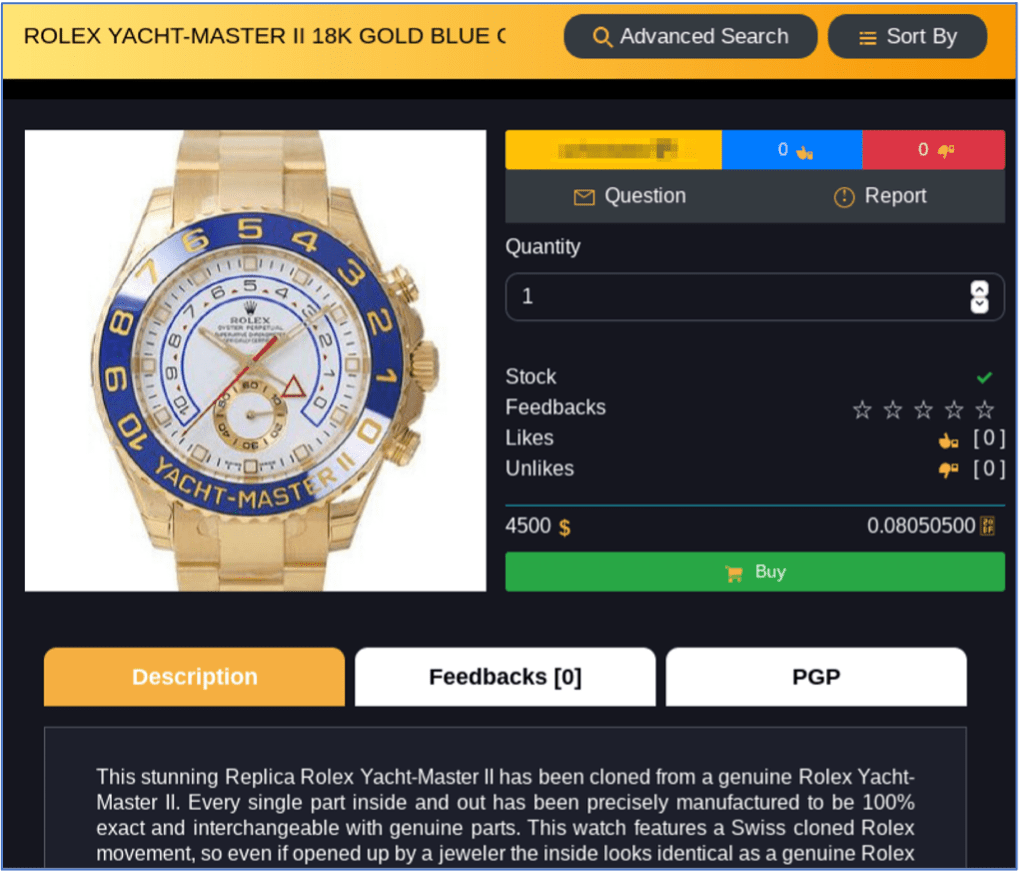
Figure 5: Darknet marketplace advertisement for counterfeit Rolex watch for $4500 USD.
Executives and key leaderships are critical targets
Some criminals utilize traditional open-source intelligence (OSINT) techniques to uncover the names, e-mail addresses and family relationships of an organization’s executives and key leadership to conduct pointed phishing campaigns via e-mail, SMS or traditional in-person and telephone-based social engineering to gain malicious access to a corporate victim’s network.
Popularly targeted executives include Facebook’s Mark Zuckerberg, Amazon’s Jeff Bezos and Twitter’s Jack Dorsey who often appear on the darknet in public “dox,” (defined both as a verb and noun) to publicly name or publish private information about that person — or the personal information published — especially as a way of punishing the person or getting revenge. The emergence of such ‘dox’ across anonymous networks and criminal communication platforms increases the overall risk to a company and those individuals as the threat, i.e. intention for attack increases significantly with the mention alone.
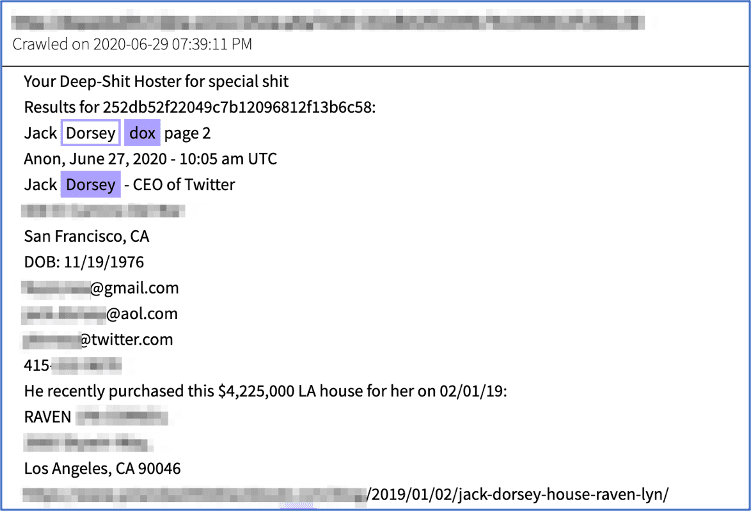
Figure 6: Source DarkOwl Vision (DocID: 585815b7bd0913ae4275f61c633ff3d107770e50)
Vendors and other third parties increase risk
As witnessed by the massive SolarWinds supply chain attack last year, nation state actors and cybercriminals are increasingly sophisticated and opportunistic seeking to exploit third and fourth party suppliers and vendors to cause harm against the victim organization. Third parties include any unit an organization works with including but not limited to vendors, such as suppliers and manufacturers, partners, affiliates, distributors, resellers, and agents. Third parties may have access to information such as: corporate sensitive data, financial data, contract terms and pricing, strategic planning data, intellectual property, credential data, personally identifiable information (PII) of customers and employees and protected health information (PHI) and can unknowingly contribute to a threat actor gaining unauthorized access to a corporate network. Today, organizations should consider investing in a comprehensive third party risk management program as discussed extensively in a recent report by Upguard.
While it is not always overtly clear who or what organization a threat actor may be intending as their next target, monitoring the darknet and deep web for mentions of a company’s name, along with names of its executives and key leadership, and network information such as domains, e-mail and IP addresses can be a helpful marker for quantifying the potential threat or intent of harm against an organization. DarkOwl’s DARKINT Exposure Scores are one of many potential quantifiable metrics a corporation can use to measure and understand a company’s business risk. Scores can also be utilized for self-risk assessments, as well as brand monitoring and vendor risk management.
Last summer, DarkOwl evaluated an assortment of industry sectors using its DARKINT Exposure Scoring system across hundreds of companies, classified as small, medium, and large for mentions of their website and email domains. Not surprisingly, Colleges & Universities had the largest scores and Insurance and Hospital & Health industries followed closely behind.
The Software Development sector had the smallest percentage of companies with no exposure, i.e. a greater volume of compromise and the industries covering Hospitals & Healthcare and Grocery Stores had the highest percentage of companies with no exposure. The raw data of which companies were included in the research and statistical analysis of the research are available for discussion upon request.
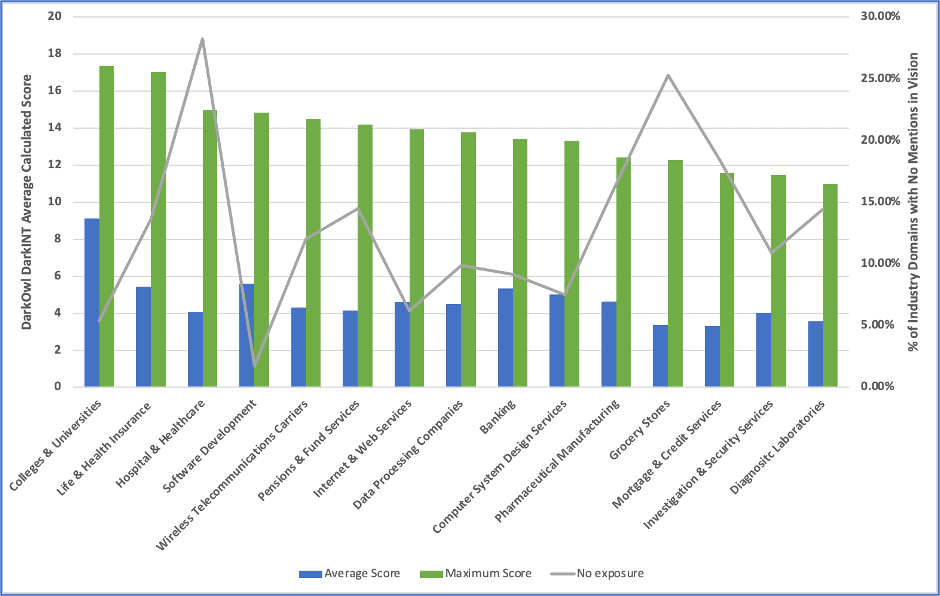
Individual Risk and the Darknet
With the most recent news of Facebook’s exposure of over 530 Million user’s e-mail addresses and phone numbers, it seems as though nearly everyone has some extent of their personal information exposed and often actively traded and sold in the underground. Threats to individual personal risk appearing on the deep web and darknet are more actually extensive than account credentials alone. DarkOwl has observed several criminals specialize in trade of other critical PII such as national identification numbers, mailing and billing addresses, dates of birth, social media profiles, and even more concerning financial data like bank account numbers and credit and debit card numbers along with their card verification values (CVVs), expiration dates and security personal pin codes.
Individuals are at risk of social engineering
Personal individual risk increases with the extent of the information exposed, where and how it has been distributed. Cybercriminals are increasingly creative in their techniques to gain access to this illicit information with astute social engineering and mass phishing campaigns. Criminals actively seek to obtain an individual’s sensitive personal information necessary for a financial institution’s security verification process such as one’s mother’s maiden name, historical personal residence and billing addresses and answers to key security questions, sometimes obtained through links to phishing website or “fake” copies of popular commercial websites with username and password login form fields, sent through “SMS bomb” or spam e-mail phishing attacks. A popular technique — both discussed openly with methods traded in underground forums — is sending out fake mobile phone notifications. Spammers text delivery notices via SMS with a link to a phishing URL (often a shortened URL, e.g. “bit.ly”) for companies like DHL or UPS that are designed to harvest the victim’s mobile IP address, IMEI number, mobile phone model and software version along with sensitive personal information input by the victim in search for the non-existent package. The Federal Trade Commission (FTC) issued advisories early last year on how to recognize a widely distributed FedEx scam via SMS text message and in February researchers reported that over 10,000 Microsoft users were affected with a FedEx phishing campaign that was not detected by Exchange Online Protection (EOP) or Microsoft Defender for Office 365.
The risk of password reuse and credential stuffing
Credential stuffing is a widespread technique utilized by cybercriminals to test if historically exposed e-mail addresses and password combinations are valid logins across multiple commercial websites. For example, many victims exposed by the MyFitnessPal data breach may have changed the password on their compromised personal account, thinking innocently they had successfully protected themselves; however, the victim continued to use the same compromised e-mail address and password combination from MyFitnessPal to login to shop on Nike’s website for fitness related equipment.
Opportunistic cyber criminals automate the testing of large ‘combo lists’ containing compromised e-mail addresses and passwords against commercial websites and once a successful authentication occurs readily steals the PII and financial information, often saved, on the e-commerce shopping platform’s user profile. Last week, the largest combination list of all time known as COMB or Compilation of Many Breaches, consisting of over 3.2 billion e-mail addresses and cleartext passwords from data breaches going back as far as 2012 were shared on a darknet hacker forum.

Figure 7: Advertisement for a breach compilation
Circling back to the overlap between individual and corporate risk, credential stuffing using malicious software and botnets affects not only the individuals but also the commercial organizations whose user accounts are surreptitiously accessed, as many immediately assume access was achieved due to vulnerabilities with the commercial service provider’s technical configuration instead of a simple credential stuffing technique conducted en masse. The uncertainty potentially erodes consumer and stakeholder confidence warranting that commercial agencies consider credential stuffing in their internal security frameworks and corporate risk assessments as well.
The risk of identity theft and financial fraud
While a personal e-mail address or password leak is easily mitigated by using complex passwords and password managers, the greatest threat to an individual is financial fraud and/or personal identity theft.
Aggregated compromised personal data about an individual, referred by underground actors as “fullz,” and sometimes augmented with data gathered via criminals who have conducted attacks against insurance, mortgage, and credit agencies, is assumed to be used in some attempt to defraud a program for monetary gain or personal identity theft with very strong likelihood as witnessed with large scale pandemic unemployment assistance fraud conducted over the last year.
Individual risk calculations
Ultimately, what does the fact any of your personally identifiable information is on the darknet really mean? Your level of concern is directly correlated to your individual risk and calculating individual risk using information exposed on the darknet is measured by not only the location of and volume of credentials and PII exposed, but also a factor of time – that is, how long the information has been available and the likelihood of exploitation by a malicious actor. Of course, this likelihood of occurrence increases immediately once there is direct intent and targeting of the person either individually or in conjunction with a campaign against a corporation, regardless of what types or volume of personal data is already accessible.
-
E-mail address and password leaks: Individual risk increases slightly with the website where the credentials have been used, i.e. banking application or health portal. Individuals can mitigate risk by using unique, complex passwords and password managers.
-
Personal financial data like credit and debit cards: Individual risk is higher if the card is still in use. Most banks have fraud prevention and do not hold the cardholder responsible for illegal purchases with stolen credit and debit card data.
-
Identity verification information: Individual risk increases with the more sensitive data accessible to a threat actor. For example, if a bank account number along with the full name of the account holder, their physical residential addresses, and other key identity verification information such as their mother’s maiden name, the name of their first dog, and secondary school mascot is obtained, then a threat actor has enough information to impersonate them and take control of the account. Compromise can be mitigated by visiting the bank in person with a form of identification (passport or driver’s license), closing down the compromised account, and opening a new one.
Only an individual can ascertain the degree of personal cybersecurity risk they are comfortable with, given the types of information they have shared publicly and the value they place on their personal information, their individual brand, and digital reputation. In a hyper-connected society that is increasingly reliant on networked digital information systems to function, everyone’s exposure and subsequent risk is increasing to some extent. For some individuals, this risk is gradual and others exponential.
It’s Risky Business Regardless
Threats posed to individuals and corporations from the darknet where sensitive corporate or personal information is leaked by cybercriminals is diverse. Criminals employ increasingly sophisticated social engineering and technical attack vectors to pilfer information that could lead to full identity theft for an individual or corporate extortion with multi-billion ransom demands.
Whats more, threat attack vectors and vulnerabilities are rapidly evolving. With the now global acceptance of Bitcoin and companies like Tesla accepting Bitcoin payments to purchase their vehicles, soon cryptocurrency addresses for individuals and companies will have to be considered in this model and protected accordingly, if they are not already being targeted for middleman attacks. The deep web, anonymous networks, and various chat platforms will continue to be home for trading these commodities of data and DarkOwl will continue to assist its clients and partners to help provide the most comprehensive darknet database necessary for critical monitoring of potential markers of cybersecurity risk to corporations and individuals.
Explore the Products
See why DarkOwl is the Leader in Darknet Data
Products
Services
Use Cases















